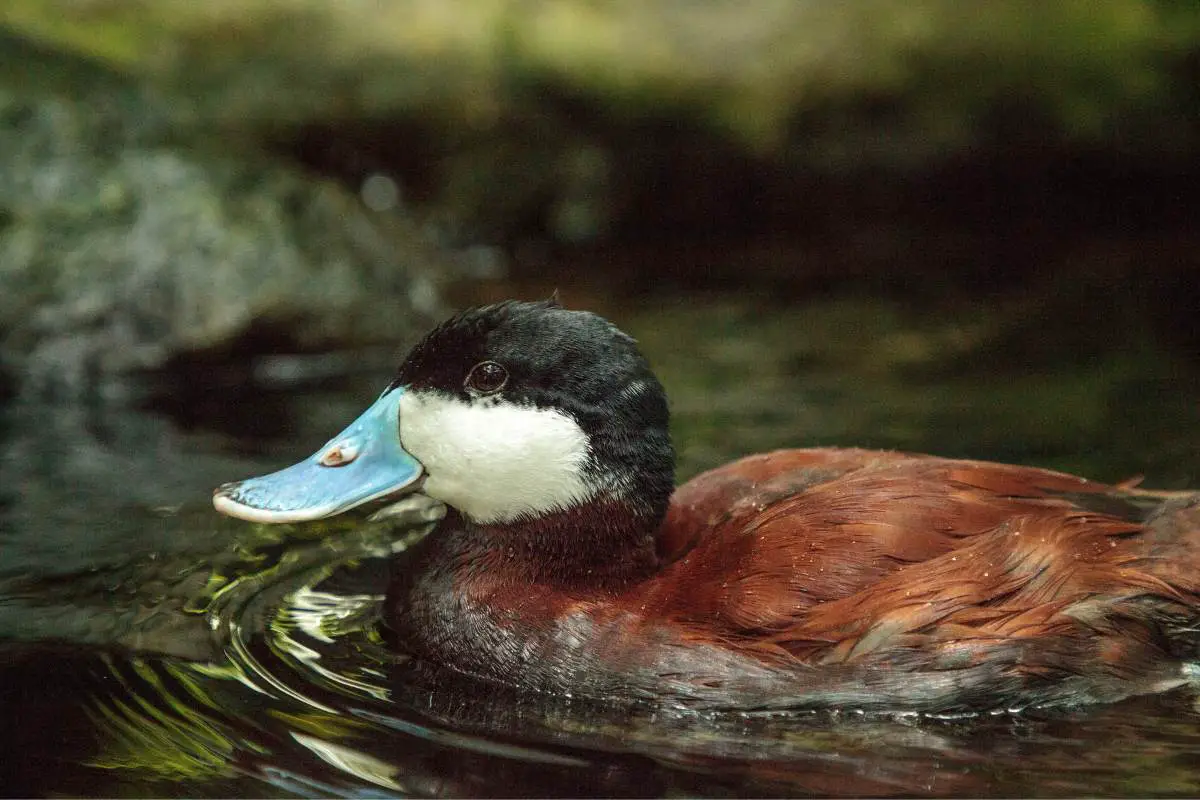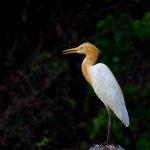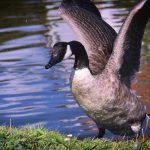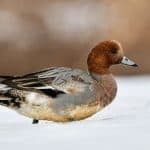Common Name: Ruddy Duck
Scientific Name: Oxyura jamaicensis| Size | Diet | Range in Hawaii | Status in Hawaii |
|---|---|---|---|
| 12 in. - 14 in. | insects, crustaceans, mollusks, and small fish | Unknown | Introduced, Least Concern |
The Ruddy Duck (Oxyura jamaicensis) is a small, diving duck that is native to North America. Despite its diminutive size, this fascinating bird is known for its unique mating behavior and distinctive blue bill. Interestingly, the Ruddy Duck has also been introduced to Hawaii, where it has become an established non-native species.
In this article, we’ll take a closer look at the Ruddy Duck’s characteristics and behavior, as well as its presence in Hawaii and the impact it has had on the local ecosystem. So, grab your binoculars and let’s dive into the world of the Ruddy Duck!
Ruddy Duck
Appearance

The Ruddy Duck is an intriguing waterfowl species known for its distinct appearance. With males measuring 14 to 16 inches and females measuring 12 to 14 inches, these ducks showcase remarkable diversity in size. The males exhibit vibrant rust-red bodies, blue bills, and mesmerizing pale blue eyes, while females display mottled brown plumage for effective camouflage.
Diet
These ducks are known to be diving specialists, capable of plunging underwater in search of their preferred prey. Their diet primarily consists of aquatic invertebrates, such as insects, crustaceans, mollusks, and small fish. Ruddy Ducks use their specialized bills to capture and consume these underwater delicacies.
Nesting
The nesting habits of Ruddy Ducks are both intriguing and well-suited to their aquatic environment. These ducks prefer to nest in dense vegetation near the water’s edge, creating a hidden sanctuary for their offspring.
The female Ruddy Duck takes charge of constructing the nest, using surrounding plant material, reeds, and grasses. She skillfully weaves these materials into a bowl-shaped structure, carefully lining it with down feathers for added comfort and insulation.
What sets Ruddy Ducks apart is their ability to build their nests floating on water, creating a secure refuge for their eggs. This adaptation allows them to select nesting sites in shallow water, such as marshes, wetlands, or even the edges of lakes and ponds.
Once the nest is complete, the female lays a clutch of eggs, usually ranging from 6 to 15 in number. The eggs are creamy white in color and are incubated by the female for approximately three weeks. During this time, she diligently tends to the nest, ensuring the eggs are protected and maintaining their temperature.
After hatching, the downy chicks leave the nest and venture into the water, guided by their attentive mother. The young Ruddy Ducks quickly become proficient swimmers, honing their diving skills and adapting to their aquatic environment.
Behavior
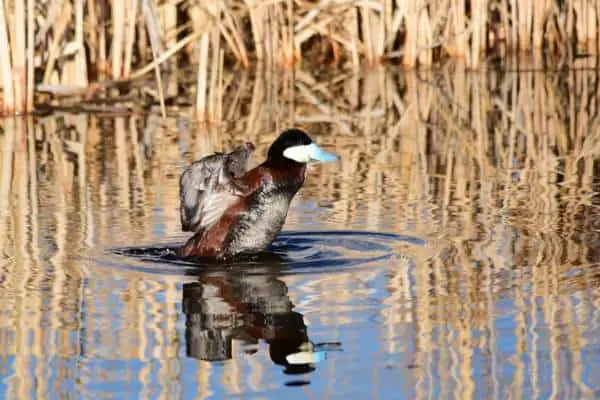
One notable behavior of Ruddy Ducks is their remarkable diving ability. They are adept divers, capable of submerging themselves underwater for extended periods in search of food. With their streamlined bodies and lobed feet, they propel themselves underwater with agility, reaching impressive depths and staying submerged for several seconds or even minutes.
During courtship displays, male Ruddy Ducks showcase their unique behaviors to attract females. They engage in elaborate courtship rituals that involve a combination of head-bobbing, head-shaking, and even swimming in rapid circles. These captivating displays not only impress potential mates but also demonstrate the males’ strength and vitality.
Ruddy Ducks are also known for their distinctive breeding behaviors. During the breeding season, males establish and defend territories, engaging in aggressive displays to protect their chosen area. This includes raising their tail feathers, inflating their necks, and emitting distinctive vocalizations to ward off intruders and rivals.
In terms of social behavior, Ruddy Ducks are typically seen in small groups or pairs. However, they can also gather in larger flocks, especially during migration or when wintering in more open waters. Despite their smaller size compared to other waterfowl species, Ruddy Ducks can exhibit assertiveness and dominance when interacting with other individuals.
Habitat
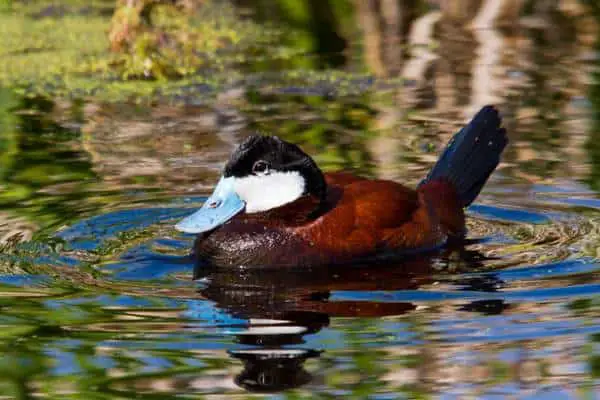
These ducks can be found in various wetland environments across North America. Ruddy Ducks are commonly seen in freshwater habitats such as marshes, ponds, lakes, and reservoirs. They prefer areas with abundant vegetation and dense emergent aquatic plants, as these provide cover and nesting sites.
Range
The Ruddy Duck is a non-native species that was introduced to Hawaii in the early 1900s for hunting purposes, but there is no established population of this species in Hawaii.
Conservation Status
According to the International Union for Conservation of Nature (IUCN), the Ruddy Duck (Oxyura jamaicensis) is currently assessed as a species of “Least Concern” in terms of conservation status. This classification indicates that the species is not facing imminent threats of extinction on a global scale.
Interesting Facts
1. Acrobatic divers
Ruddy Ducks are excellent divers and can submerge themselves underwater for extended periods. They use their lobed feet and wings to propel themselves underwater, reaching depths of up to 10 meters (33 feet). Their diving abilities allow them to forage for aquatic invertebrates and small fish.
2. Variable plumage
Ruddy Ducks exhibit differences in plumage between breeding and non-breeding seasons. Male breeding plumage is characterized by a striking rust-red body with a blue bill, while non-breeding males resemble females with a more subdued brownish appearance. This change in appearance allows for better camouflage and reduces aggression between males outside the breeding season.
3. Fast flight speed
Ruddy Ducks are agile flyers and can reach impressive speeds during flight. They can fly at speeds of up to 50 miles per hour (80 kilometers per hour), allowing them to cover long distances efficiently.
4. Unusual tail shape
Male Ruddy Ducks have unique, stiff, and pointed tail feathers that give their tails a distinctive shape. This specialized tail structure contributes to their buoyancy and helps with maneuverability while swimming.
5. Noisy communicators
Ruddy Ducks are not particularly vocal, but they do produce a variety of sounds for communication. Males emit soft grunting or croaking sounds during courtship displays, while females make soft quacking noises.
Frequently Asked Questions
1. Can Ruddy Ducks walk on land?
Ruddy Ducks are primarily adapted for life in water, and their leg placement towards the rear of their body makes walking on land awkward for them. They are more comfortable and agile in the water, using their lobed feet for swimming and diving. However, they can waddle on land for short distances if necessary.
2. Do Ruddy Ducks make good pets?
Ruddy Ducks are wild waterfowl and are not recommended as pets. They have specific habitat and dietary requirements that are difficult to replicate in a captive setting. Additionally, keeping wild birds as pets may be illegal in many areas without proper permits. It is best to appreciate Ruddy Ducks in their natural habitats.
3. Can Ruddy Ducks interbreed with other duck species?
Ruddy Ducks have been known to hybridize with other duck species, particularly with the introduced European Ruddy Duck (Oxyura jamaicensis ferruginea). Hybridization can occur when these species come into contact, leading to genetic introgression and potential population declines of pure Ruddy Ducks. Monitoring and management efforts are in place to mitigate the impacts of hybridization on Ruddy Duck populations.
4. Are Ruddy Ducks aggressive towards humans?
Ruddy Ducks are generally not known to be aggressive towards humans. They are shy and tend to avoid close human interactions. However, like any wild animal, they may exhibit defensive behavior if they feel threatened or cornered. It is best to observe and appreciate Ruddy Ducks from a respectful distance to ensure their well-being and minimize disturbances.
5. What is the lifespan of Ruddy Ducks?
The average lifespan of Ruddy Ducks in the wild is estimated to be around 5 to 7 years. However, some individuals can live longer, with records of individuals reaching up to 15 years of age. Factors such as predation, disease, habitat quality, and environmental conditions can influence their overall survival rates.
